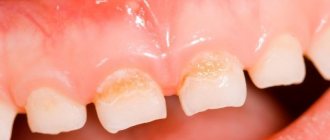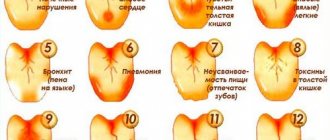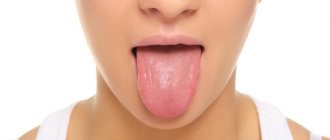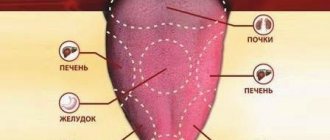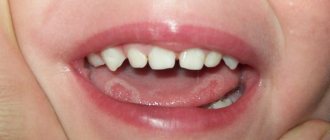There is an opinion that the tongue is a mirror of health. By its color one can judge anonymous processes and various anomalies in the body. For example, a white coating on the baby’s tongue may indicate thrush or diet (milk traces). If such signs appear in children over 1 year of age, this may indicate problems with the gastrointestinal tract (gastrointestinal tract), a viral disease or stomatitis.
Standards for the appearance of plaque on the tongue of children
Sometimes you can notice a thin layer of white coating on the surface of the tongue - it is not accompanied by an unpleasant odor and disappears a few hours after eating or taking a sip of water. This phenomenon cannot be called a sign of the presence of a serious disease, which means that the tongue of a healthy child can be either light pink or have a white tint.
In children over one year old who eat from a common table, the appearance of a whitish coating on the tongue is acceptable in the morning - this is due to natural processes in the body when fungi, microbes and bacteria absorb food debris and leukocytes. Such plaque should be easily removed with a toothbrush and should not appear again during the day.
Also, non-pathological reasons for the appearance of plaque include:
- Insufficient oral hygiene - bacteria multiply and form a white coating if the baby does not brush his tongue and teeth well.
- An abundance of dairy products, cottage cheese, ice cream, flour and other confectionery products made from white flour, biscuits or with protein cream in the child’s diet.
- Teething or replacement of milk teeth with molars.
- Often breathing is not through the nose, but through the mouth.
- “Geographic tongue” is the appearance of whitish spots on the child’s tongue, reminiscent of objects on a geographical map. This may be a congenital feature that does not leave a person throughout his life and does not require treatment.
If a coating on the tongue appears as a result of some kind of malfunction in the body, it is almost impossible to determine it “by eye”. Only a doctor can make a diagnosis based on test results. But parents themselves are able to understand that something is wrong with their child by examining the tongue on which the coating has appeared for several days. The following changes should alert you:
- A dense layer of plaque that cannot be cleaned off with a toothbrush and quickly grows again.
- A thick layer of plaque that rises several millimeters above the tongue, like a cap.
- The consistency of the plaque: loose or wet, on the contrary – dry, covering the tongue with a crust.
- Change in plaque color - from white it can become greenish, yellowish or acquire a different shade, regardless of the food the child eats.
- Teeth marks are imprinted and remain on the plaque layer.
- There is an unpleasant, pungent odor coming from the child’s mouth.
Features of consistency and thickness of plaque
Important! Having noticed a white coating on a child’s tongue, parents should pay attention to the structure and density of the deposits, which may vary depending on the cause of the appearance of the deposits.
- A thin layer of uniform plaque occurs during viral infections;
- A small layer of dry plaque forms during dehydration;
- Thick plaque with a heterogeneous structure is characteristic of stomatitis;
- A wet, dense layer of deposits indicates problems with the digestive tract;
- A thick layer of whitish plaque , under which the main color of the tongue is not visible, indicates the presence of severe chronic diseases.
Pathological factors for the appearance of white plaque
There are at least a dozen reasons that could lead to the formation of a whitish coating on a child’s tongue. Conventionally, they can be divided into several groups, which is easier and more visual to do in the form of a table.
Gallbladder tubing (blind probing) is an alternative healing technique that can be used at home to eliminate congestion in the gallbladder and bile ducts. Read more in the article: “how to make tubage.”
Table 1. Plaque formation factors
Intestinal infarction is a disease in which blockage of the bloodstream of the mesentery occurs, and then, due to acute disruption of the blood supply, necrosis of the intestinal wall. Read more in the article: “intestinal infarction: what is it?”
| Type of problem | What's the point? |
| Gastrointestinal diseases | Pathologies of the digestive tract are reflected in the tongue already in the first days of appearance. With gastritis, colitis, ulcers, pancreatitis, problems with the biliary tract, the tongue becomes coated. |
| Colds, infectious (viral) diseases | Flu, ARVI, scarlet fever, tonsillitis, measles are characterized by severe white rashes on the tongue. Doctors often note on a young patient’s chart: “The tongue is coated.” |
| Oral diseases | Caries, pharyngitis and laryngitis, inflammation of the salivary glands and tongue appear as a whitish coating. |
| Fungal diseases | Candidiasis or thrush is a common occurrence in infants, characterized by abundant growth of fungus in the body. In this case, a whitish coating forms on the mucous membranes. |
| Parasites | Plaque on the tongue is a common sign of helminthic infestation in the body. This is due to immune abnormalities and an increase in the level of eosinophils in the child’s blood. |
| Anemia | As a result of a decrease in hemoglobin and red blood cells, the child’s body receives insufficient oxygen, all organs suffer, the tongue signals a problem by the appearance of plaque. |
| Dehydration, intoxication | When the child consumes a small amount of fluid and there is an imbalance in the electrolyte balance in the oral cavity, dryness and a coating that crusts the tongue are observed. When the body is intoxicated, the tongue is coated with a “cotton” coating. |
| Allergy | In case of allergic reactions, the baby's tongue may swell, acquire a whitish tint, and become coated. Characterized by dry mouth and lack of saliva in the required amount. |
| Failure of the immune system, taking pharmaceutical drugs | Frequent illnesses, taking antibiotics and other medications, low activity are the prerequisites for the appearance of plaque on the tongue. |
| Other | Lack of vitamins, macro- and microelements, chronic diseases, overwork, weather conditions can affect the appearance of plaque on a child’s tongue and changes in its characteristics. |
Why does a child have a white coating on his tongue?
Probable reasons:
- inflammatory processes on the mucous membranes inside the oral cavity;
- dental diseases;
- digestive problems;
- infectious diseases;
- colds;
- diseases of the respiratory system;
- psoriasis;
- allergic reaction;
- dehydration.
The tongue should be examined, paying attention to the thickness of the plaque layer, its density, shade (yellowish, grayish, bright white), location (in the center, along the edges, closer to the root of the tongue). Depending on these factors, a specific disease can be suspected. In newborns and infants, the most common cause is oral candidiasis (thrush). Manifestations:
- redness of the mucous membranes of the entire oral cavity;
- formation of cheesy lumps, plaques on the tongue, inner surface of the lips and cheeks;
- child's anxiety due to pain, burning, itching in the mouth.
Diagnostics according to Ayurveda
This ancient medical practice also has its own vision of diseases characterized by a coating on the tongue. There is even an Ayurvedic map showing how the location of plaque on the tongue is associated with pathologies of various organs. Of course, such a card does not have official medical recognition and confirmation, but many parents who discovered plaque in their child’s mouth checked this card and received similar results of tests and examinations.
Using an Ayurvedic card for self-diagnosis and unauthorized prescription of treatment and therapy for a child is absolutely impossible! This is only an auxiliary tool that allows parents to analyze the baby’s health status before going to the hospital.
Table 2. Ayurvedic map deciphering the cause of plaque on the tongue
| Localization and nature of plaque on the tongue | Which organ should you pay attention to? |
| White coating along the edges of the back third of the tongue, near the pharynx | Kidneys |
| The anterior third of the tongue is covered with a whitish coating | Heart |
| Plaque accumulates on the tip of the tongue and along the edges | Lungs |
| Plaque in the middle of the tongue | Stomach, spleen, pancreas |
| The sides of the tongue are coated | Liver |
| Plaque collects in a fold in the middle | Spine |
| Plaque on the root of the tongue | Intestines |
The influence of thrush on the child’s condition
With candidiasis, the baby’s general condition worsens, he becomes capricious, lethargic and refuses to eat. Candida spots in the mouth cause severe discomfort to the baby; sucking the breast or bottle becomes painful for him, and because of this he constantly cries. In rare cases, there is an increase in body temperature, as with a cold, sometimes it reaches 39 degrees.
Candidiasis rarely affects only the tongue. Usually the entire oral cavity becomes covered with white spots, even the area around the mouth can be affected by the fungus. When the baby eats, the plaque peels off and disappears for a while, and the inflamed mucous membrane of the mouth is visible.
Which doctor should I contact?
The first specialist you need to contact after identifying a tongue coated with a white coating is a pediatrician. After carefully examining the child’s oral cavity, the doctor will assess the condition of the teeth and gums and check the lymph nodes. After this, he will make a diagnosis and prescribe effective medications to eliminate the underlying disease.
If it was not possible to determine the cause of the formation of layers during the examination, the pediatrician will give a referral to an infectious disease specialist, gastroenterologist, endocrinologist or other specialized specialists. In some cases, doctors prescribe a bacterial culture from the surface of the tongue and a general blood and urine test. Based on the results of laboratory tests and examination, the small patient will be prescribed suitable treatment.
What should parents do?
In cases where a white coating appears on a child’s tongue only in the morning or after eating dairy food, is easily removed and does not return during the day, this should not cause concern to parents. For infants and children under one year of age, plaque from the tongue can be removed with a finger wrapped in a piece of clean gauze or bandage. Finger movements must be careful. For older children, plaque is removed from the tongue using a soft toothbrush. It is safe for children of any age to treat the oral cavity with a soda solution.
For a child over 3 years old, the solution is used as a rinse; for younger children, the tongue is wiped with a gauze swab dipped in a soda solution. If the white coating is difficult to clean off from the surface of the tongue, does not disappear within several days, or is accompanied by a burning sensation and painful sensations, parents should show the child to the doctors. These may be specialists such as a dentist, pediatrician, gastroenterologist. Only a doctor can make a correct diagnosis and prescribe effective treatment for a child.
Associated symptoms
In addition to a white coating on the surface of the tongue, when pathology develops, a child may develop other symptoms that can cause him a lot of inconvenience.
Reference! The following symptoms indicate the need to visit a pediatrician as soon as possible:
- bitter taste in the mouth;
- bad breath;
- fatigue, drowsiness;
- general weakness;
- heartburn or belching;
- nausea;
- swollen lymph nodes;
- excessive sweating;
- pale skin;
- muscle pain;
- redness of the tongue;
- increased body temperature;
- skin rashes;
- a sore throat;
- dry skin and mucous membranes;
- formation of ulcers or wounds in the mouth;
- constant thirst;
- irregular urination;
- change in urine color;
- diarrhea or constipation;
- headache;
- lack of appetite;
- redness of the oral mucosa;
- dark circles in the eye area;
- short sleep;
- passive state.
Let's sum it up
Modern doctors, just like their ancient predecessors, rightly consider the condition of the tongue to be one of the criteria for human health. When examining the tongue, its mobility, density, color, moisture, presence or absence of plaque and other factors are assessed. A white coating found on a child’s tongue can be a “signal” of the onset of a disease, even in cases where other symptoms have not yet manifested themselves. In this case, the coating can cover both the entire surface of the tongue and its individual sections, be dense or loose, and be easily or difficultly removed from the surface of the tongue.
Treatment
It is worth noting! Treatment is carried out taking into account the cause of the symptom and the individual characteristics of the child’s body.
To eliminate white plaque and underlying pathology, the following are used :
- antibacterial, anti-inflammatory and immunostimulating drugs - for the treatment of infectious diseases;
- antiseptic solutions, regenerating and painkillers - for the treatment of stomatitis;
- antacids, prebiotics and enzyme preparations - to normalize the functioning of the digestive tract.
Note! Many doctors advise cleaning a child’s tongue with a soda solution or herbal infusions.
However, when using such products, you should first make sure that the baby is not allergic to the components included in the medicinal rinses prepared at home.
To avoid the appearance of white plaque, parents of a preschooler should also adhere to the following rules:
- Keep your child's hands clean and teach him proper oral hygiene.
- Make sure your baby does not have a dry throat and regularly give him warm water to drink.
- When identifying various diseases, do not self-medicate , but immediately seek help from a specialist.
- Provide your child with a nutritious diet with enough fresh vegetables and fruits.
- Ventilate the room in which the child is located, and also carry out wet cleaning.
Useful video
From this video you will learn how to treat oral thrush in children:
To understand whether plaque on the surface of the tongue of a preschooler or a child of primary school age is normal, you need to take into account not only the color of the deposits, but also their location, density, and structure.
It is important for parents to remember that pronounced symptomatic manifestations that persist for several days require contacting a medical institution for qualified help.
You cannot ignore the symptoms, because this can lead to extremely negative consequences.
